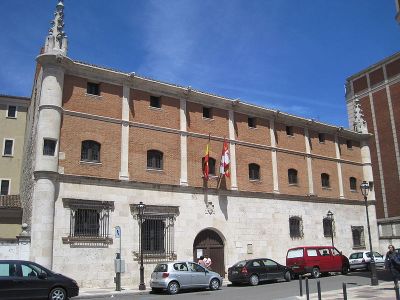The Casa Miranda is a 16th century Renaissance palace ordered to build by the canon and prothonotary Don Francisco de Miranda y Salón. The building is made of ashlar stone on the ground floor and brick on the upper floors. Gothic architectural elements survive in the building, such as the corner towers and the gargoyles on the eaves of the roof.
The courtyard is the most important architectural element of the entire building. It also serves as a distribution space for all the Museum’s rooms. It has a rectangular floor plan and a double gallery articulated by eighteen columns with tripartite shafts topped by a composite capital.
The upper gallery is enclosed by balconies decorated with bas-reliefs of busts, animals, human figures and family coats of arms.
The staircase leading to the upper floors is the only one that has survived from the original construction. The staircase is carved with cloth garlands, fantastic animals and candelieri motifs.
The palace of Iñigo Angulo is a civil construction dating from the mid-16th century. It was built by the master builder Juan de Vallejo, commissioned by Don Lope Hurtado de Mendoza. It has a quadrangular floor plan flanked by two quadrangular towers on either side.
This palace was acquired by the Angulo family, whose name it retains today, in 1775. During this period, the building underwent important remodelling work.
The courtyard is the most important architectural element of the entire building. It also serves as a distribution space for all the Museum’s rooms. It has a rectangular floor plan and a double gallery articulated by eighteen columns with tripartite shafts topped by a composite capital.
The upper gallery is enclosed by balconies decorated with bas-reliefs of busts, animals, human figures and family coats of arms.
The staircase leading to the upper floors is the only one that has survived from the original construction. The staircase is carved with cloth garlands, fantastic animals and candelieri motifs.
The palace of Iñigo Angulo is a civil construction dating from the mid-16th century. It was built by the master builder Juan de Vallejo, commissioned by Don Lope Hurtado de Mendoza. It has a quadrangular floor plan flanked by two quadrangular towers on either side.
This palace was acquired by the Angulo family, whose name it retains today, in 1775. During this period, the building underwent important remodelling work.

